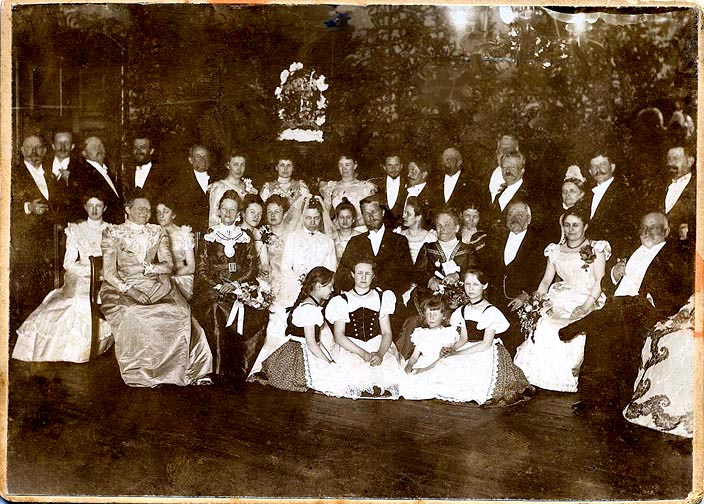
My
Father's Ancestors
before 1900
For a table of names and dates of the Gross Ancestors – click Ahnentafel (Version 2002)
For
a Google Earth .kmz file with placemarkers for the villages and
cities where the Gross Ancestors lived – click here: Google
Earth Map
This
operation requires that you have Google-Earth installed on your
harddisc.
On
a recent visit (March 2008) my cousin Peter Schmidt brought me an
envelope with photos of our common Gross-Handtmann-Kiepert ancestors.
Here they are annotated with whatever stories I remember. If you have
more share them with me. This is not a public website.
The prize is a large photograph of grandfather Gross' Wedding with Margarethe Handtmann in Bernstadt in May 1900.
Die “Japanische Hochzeit”
I have no idea why great-grandfather Paul Handtmann, who was the host at this wedding called this photo “The Japanese Wedding.” It records the day on which the Gross and Handtmann-Kiepert clans joined hands.
Paul Handtmann was feared for his sharp verbal bon mots, so maybe this was one of those. On the back of the photo he wrote down a list of names, with titles of course. The young girls whose names he can't remember he simply calls Stock, “brood”.
The wedding of my grandparents Werner Gross and Margarethe Handtmann in Bernstadt, Silesia (now Bierutow, Poland) on 20 May 1900.
Click on the photo to read my great-grandfather's notes.
Take a look at the Inner Circle: Werner Gross, tilting his head in resignation and his bride, Margarethe Handtmann, staring at the photographer as if she was going to kill him. The Buddha behind them is Agnes Kiepert, Liane Kiepert's niece. On Werner's left sits with a smile the bride's mother, Liane Handtmann, born Kiepert. Her husband Paul Handtmann, can be seen in the first photo to the left of her (He is blurred in the original).
To the far right of grandmother sits Werner's mother, Elisabeth Gross, born Thilo. At the time of this picture she had been a widow for ten years. Werner's father Julius Gross, director of the Bürgerschule “Gymnasium” in Görlitz, had died early in 1890. Money was short. Werner's older brother Konrad accepted a good position as botanist in St. Petersburg, Russia, and Werner had decided to study protestant theology, it lay in the fasmily and the church offered to pay part of his education.
This is the only photo of my grandfather Werner in his younger years. A few months before his wedding he had been elected pastor in Sacro a small village near Forst, Silesia and has remained in my memory as the most imposing figure after God himself - with his full, white beard, he also looked good on photographs. By contrast grandmother always looks like a witch casting an evil eye on the photographer. She was not a happy person, but she was not outright evil.
Looking at this picture for as long as I have now, it seems that Werner got his good looks from his mother Elisabeth - who got hers from her father Emil Thilo.... The Handtmann and Kiepert by comparison have round and comfortable faces - like Liane Kiepert -Handtmann. On the other hand, the two conspiring ladies in the second row between Elisabeth Gross and my grandmother are another Kiepert niece, Gertrud and her friend Gertrud Langerhans the niece of the famous physiologist Paul Langerhans, who discovered the Langerhansschen Inseln in the pancreas – and hence diabetes.

Here is another photo of this wedding, Die Nachhochzeit, "Post-Wedding" with Paul Handtmann's handwritten names on the bottom. Most people I cannot identify, only a few seem to be relatives. The most striking figure in this photo - and the reason d'etre for reproducing it here is Paul Handtmann who thrones wearing a bowler hat on the balustrade. Modest Liane sits in the center.
%20Handtmann.jpg)
Another photo of Paul Handtmann and Liane in his best years (~1910) . Liane Handtmann was the daughter of Heinrich Kiepert, the highly regarded cartographer and professor of geography in Berlin. It must be through her that my father, I, and Cornelius inherited the fascination with geography and maps. - My father will turn in his grave, but it was again and again the women who brought the most interesting genes into the Gross family. Liane died 1915 in Görlitz and Elisabeth Thilo-Gross died 1905 in Sacro.
Paul Handtmann had been the director of a sugar refinery in Bernstadt (now Bierutow, Poland) – an “industrialist” of the Gründerjahre, “Founder's Years”. He had money, a commodity nobody else had in our family. How did the penniless pastor, persuade Paul to give him his daughter? The answer I only found out on a recent visit to Sacro. - Paul, after he had lost his fortunes in the inflation, had to suffer through his last years at grandfather's impoverished parsonage in in Sakro walking up and down the sandy main street muttering to himself - “alles Scheisse!”. He died there in 1927.
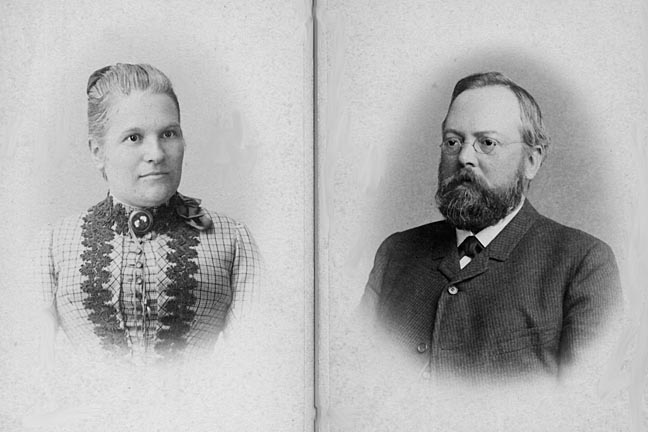
Liane Kiepert Handtmann and Paul Handtmann around 1890
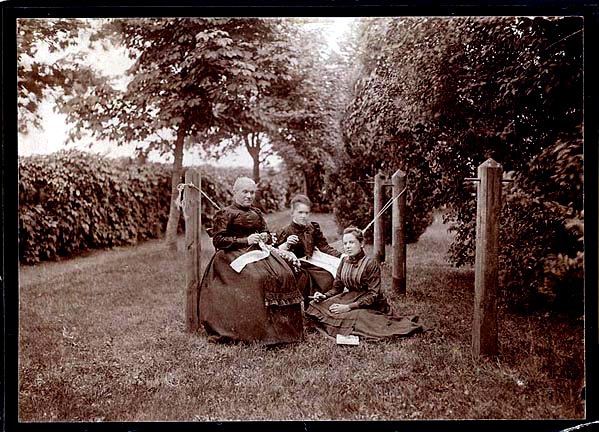
Liane Handtmann with Gertrud and Agnes Kiepert, her nieces (~1895)
|
Liane knitting (1880s) |
and her famous father Heinrich Kiepert, Professor at Berlin University (1875s). Photo from Wikipedia |
My father remarked that Heinrich Kiepert had the typical Slavic features od the Wenden around Sacro. Sdid he also have, hair on his back - as I do? - another Slavic trait! May that be as it is, look at the "aristocratic" features of the further removed generations of the Handtmanns and their wives:
|
Ottilie Kolshorn Handtmann, the wife of Joseph Handtmann and mother of Paul (1860s). The Kolshorns were merchants in Braunschweig and go back to the 16th century |
Joseph Handtmann, Paul's father, königlich geheimer Ober-Post-Rath in Koblenz (1860s)
|
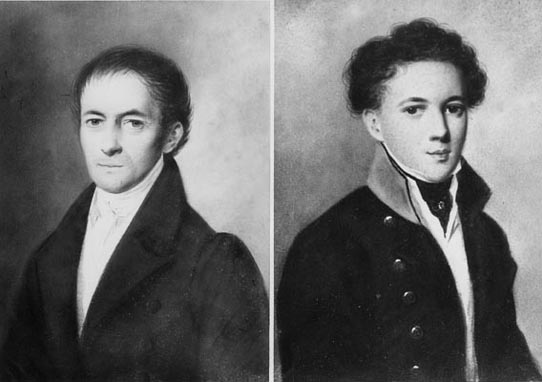
Christian Handtmann with his son Joseph as a young man. Christian was königlicher Hofgärtner in Sanssouci, Potsdam, the origine of the botanical and agricultural interests of Konrad and Werner Gross, my father down to my daughter Susanne! (oil paintings ~1828)
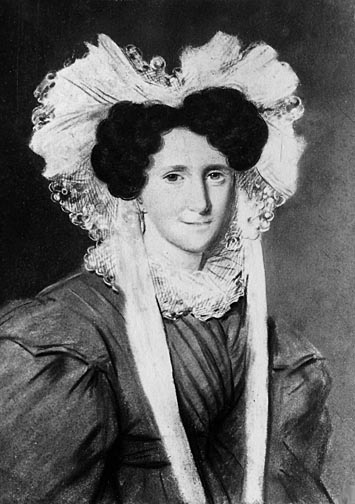
And this is intelligent-looking Maria-Theresia (sic! ) Thamm, Christian Handtmann's wife (oil painting ~1825). She came from Landeck (now Ladeck, Poland) near Glatz where Christian had worked in den friederizianischen Gärten in his young years. Friedrich II often took the "Cure" against the gout in Landeck. Friedrich Wilhelm III also suffered from gout. He must have liked the young Christian - who was moreover a Protestant - and took him along to Potsdam. - Before Frederick II of Prussia conquered Silesia from Empress Maria Theresia the Grafschaft Glatz was Austrian - hence Therese's name - she probably was Catholic – which may explain the names she gave her son: Joseph, Ignatz, Franz, Xavier, Andreas, Myosotis!!! All the saints and patrons of Catholic Silesia.
Let me return to the Gross side of my grandfather. Here is a picture of his parents

Elisabeth Thilo and Julius Gross, the founder and Rektor der Bürgerschule in Görlitz (1870s). She came from Striegau, Silesia (today Strzegom, Poland) where her father Emil Thilo owned the Hotel "Deutsches Haus". They got married there in 1862.
There are no more photos of Julius' parents, Ludwig Gross and Clementine Schott, who got married in Kreuzburg, Ober-Schlesien (now Kluczbork, Poland) in 1829, but there once existed oil paintings of Ludwig's parents,

August Gross and Charlotte Schultz who got married in Treptow an der Rega (Pomerania, now Trzebiatów, Poland) in 1795. I tried to guess from the picture what August's profession could have been - and my father had a surprise in store: He was königlicher Kapellmeister und Hofmaler, "royal music director and court painter" ! The paintings must be from around 1810.
Actually August's musical talent should not be surprising; his father was Friedrich Wilhelm Gross, the family legend: königlich priviligierter Stabstrompeter im Preussischen Kürassier Regiment Markgraf Friedrich who came to Prussia with his father Ludewig Gross as simple soldiers hired to fight the Swedes. Another version claims, they were recruited because they were so tall.
Friedrich Wilhelm (named after the Prussian King of his time) had the good fortune to marry Christiane Sophie Elisabeth Schäffer born in Wugarten in the Neumark (now Ogardy, Poland). The Schäffers were theologians and pastors from Halle an der Saale with a long line of ancestors traceable to a Novella Andreae, who was Professor of Both Laws at the University of Bologna around 1350! - This is the most romantic and remarkable trail in out family tree. According to my father's research he came from “Hall in Schwaben” where, however, father couldn't find any suitable Gross. It is my suggestion that Friedrich Wilhelm and his father Ludewig came from Halle an-der-Saale (the town Händel was born in!) where Christiane's father came from and a number of theologians by the name Andreae and Schäffer existed around that time.
And here is another impressive surprise:
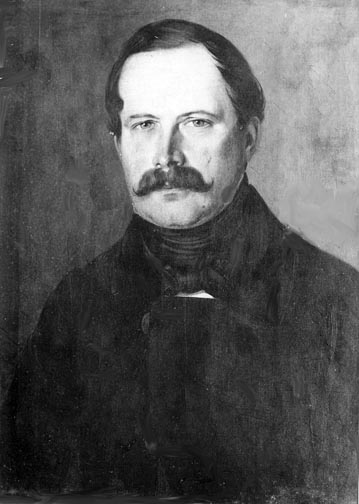
Emil Thilo (who inspired Cornelius' second given name) - the father of Elisabeth Thilo-Gross - who owned the Hotel "Deutsches Haus" in Striegau (today Strzegom) Silesia. (oil painting or photo ~1845) - Is he the source of the long facial features among some Gross and Schmidt's, which are so different from those of the round, comfortable Handtmanns?
The following oil paintings have no names. They were not large and hung in my father's study in Gelnhausen. Interesting faces! Who are they? Does anybody know?
|
|
|
|
|
|

Barbara Heug(e)lin (~1520?), the coats of arms show that she was a born von Wins ....
The story is, Johannes Kolshorn, the grandfather of Ottilie Kolshorn-Handtmann, married a Sophie von Wins who came from an old patrician family in Frankfurt an der Oder. I remember when on one of our trips to the Ostsee my excited father discovered this oil painting in a church in Frankfurt a.O. in 1940. Onkel Gerhard Schmidt had a photograph made, of which this is a copy.... I don't know why and who deleted the date and age numerals.
Miscellaneous Curiosa.
Reportedly there was one Jewish person in the family : Richard Fuchs (not to be confused with Klaus Fuchs, the Soviet spy), a mathematician who obtained his doctorate with Georg Frobenius and Hermann Schwarz at Berlin University in 1893. Richard's wife Käthe was a Kiepert. During my fathers studies in Berlin he was occasionally their guest. Apparently he belonged to the small group of protected Jewish scientists who survived. I have not been able to find moreinformation on him. Among Peter Schmidt's photos were four, the most charming is this one

Käthe Kiepert-Fuchs, Barbara, Richard Fuchs, and Dietrich. I guess the photo was taken around 1938.
|
|
|
This is "Onkel Theodor” Gross (1833-1920) and his wife "Tante Anna" from Bernstadt. He was a brother of Julius Gross, the Bürgerschule-Rektor. He appears on the top of the photo of the “Nachhochzeit” and Tante Anna sits on the right of Elisabeth Thilo Gross in the Japanese Wedding.
On a visit to Sacro in 2008 I discovered that Tante Anna had been the marriage broker between Gandfather Werner Gross and the Handtmann clan. After his father's death Theodore and Anna Gross became like parents to Werner. It was she who introduced Werner to Heinrich Kiepert - who invited him to a geographic expedition – and at her house Werner met Richard Reimann whose position at Sacro he eventually inherited.
Tante Anna departed in 1937 causing great confusion which reached down into my memory. She bequeathed her possessions on seemingly haphazardly selected members of the Gross family: Konrad Gross, then isolated in Stalin's USSR, inherited money - which he couldn't transfer without getting into political troubles. My father got a heavy dark mahogany dining table with lion feet and two huge wardrobes. My mother was appalled, but father felt obliged by Anna's generosity to attend her funeral. I still see them in the yard of father's garage in Glatz. Father's long legs dangling from the half-open door of his DKW Cabriolet, mother exhorting him for accepting this old junk, and I confused. I was 6 could not see how he would bring this load of furniture back in our small car - and how was he going to bury her ? The army spade which he had used last winter to dig the car out of a snow drift was standing in the garage. - I dragged the shovel out and pressed it on him to take it along.